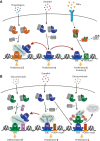Signaling pathways and steroid receptors modulating estrogen receptor α function in breast cancer
- PMID: 30181360
- PMCID: PMC6120708
- DOI: 10.1101/gad.316646.118
Signaling pathways and steroid receptors modulating estrogen receptor α function in breast cancer
Abstract
Estrogen receptor α (ER) is the major driver of ∼75% of breast cancers, and multiple ER targeting drugs are routinely used clinically to treat patients with ER+ breast cancer. However, many patients relapse on these targeted therapies and ultimately develop metastatic and incurable disease, and understanding the mechanisms leading to drug resistance is consequently of utmost importance. It is now clear that, in addition to estrogens, ER function is modulated by other steroid receptors and multiple signaling pathways (e.g., growth factor and cytokine signaling), and many of these pathways affect drug resistance and patient outcome. Here, we review the mechanisms through which these pathways impact ER function and drug resistance as well as discuss the clinical implications.
Keywords: breast cancer; cross-talk; cytokines; estrogen receptor; growth factors.
© 2018 Siersbæk et al.; Published by Cold Spring Harbor Laboratory Press.
Figures


References
-
- Abduljabbar R, Negm OH, Lai CF, Jerjees DA, Al-Kaabi M, Hamed MR, Tighe PJ, Buluwela L, Mukherjee A, Green AR, et al. 2015. Clinical and biological significance of glucocorticoid receptor (GR) expression in breast cancer. Breast Cancer Res Treat 150: 335–346. - PubMed
-
- Abrams J, Aisner J, Cirrincione C, Berry DA, Muss HB, Cooper MR, Henderson IC, Panasci L, Kirshner J, Ellerton J, et al. 1999. Dose-response trial of megestrol acetate in advanced breast cancer: cancer and leukemia group B phase III study 8741. J Clin Oncol 17: 64–73. - PubMed
-
- Alexieva-Figusch J, van Gilse HA, Hop WC, Phoa CH, Blonk-van der Wijst J, Treurniet RE. 1980. Progestin therapy in advanced breast cancer: megestrol acetate—an evaluation of 160 treated cases. Cancer 46: 2369–2372. - PubMed
-
- Altomare DA, Testa JR. 2005. Perturbations of the AKT signaling pathway in human cancer. Oncogene 24: 7455–7464. - PubMed
-
- Anbalagan M, Rowan BG. 2015. Estrogen receptor α phosphorylation and its functional impact in human breast cancer. Mol Cell Endocrinol 418: 264–272. - PubMed
Publication types
MeSH terms
Substances
Grants and funding
LinkOut - more resources
Full Text Sources
Other Literature Sources
Medical
Miscellaneous
